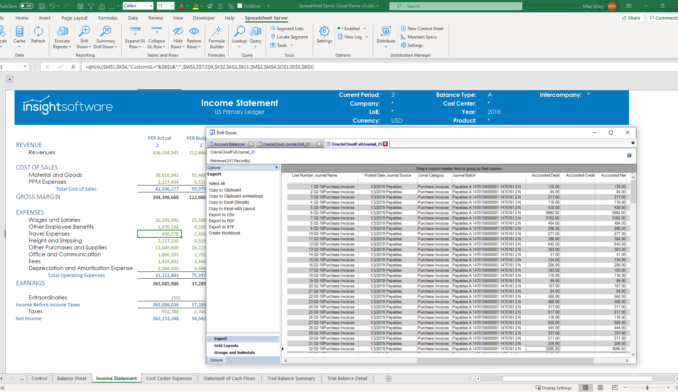Treasury Management International: Top 4 AI predictions for finance departments
I know what you must be thinking. How does artificial intelligence (AI) fit into the daily number crunch?
Richard Sampson, SVP EMEA, insightsoftware
First of all, AI is a very broad term. But it often includes – and works alongside – the optimisation of everyday processes. Any individual working in a finance department, collecting and analysing thousands of data points, would welcome any type of process optimisation to save time and money. So how do we predict the world of financial reporting is set to change as a result of AI and machine learning?
First off, AI is long-term and only part of the story. The wider story is one of automation and the search for productivity gains. This story takes us from reporting automation, through robotic process automation (RPA), before we meet AI and machine learning. Interestingly, according to a survey cited in Gartner’s Magic Quadrant for Cloud Financial Planning and Analysis Solutions report, 46% of respondents said predictive analytics is where they intended to invest the most money before 2021. The second-ranked technology was RPA (43%), followed by AI/machine learning (35%).
Here are our predictions as the modern finance department looks to the future.
1) Reporting Automation
In the world of enterprise resource planning (ERP) reporting, data extraction can be an automated process already, replacing the need for humans to manually dump data into Excel, manipulate it, and then format it. As with any manual process, this old approach to reporting is time-consuming and prone to human error.
For most finance teams, having an automated process that provides easy access to real-time information from their ERP system, with the ability to quickly answer ad hoc enquiries, and automatically produce and share periodic reports and dashboards, is the priority.
Here lie easy productivity gains that are within reach of every finance team today, whatever their size of organisation, whatever ERP system they use, whether their ERP is on-premise or in the cloud.
We predict reporting automation will continue to gain huge ground inside organisations in the near future.
2) Robotic Process Automation
The next step on the journey moves on from data automation to process automation in the guise of RPA.
According to the Institute of Electrical and Electronics Engineers Standards Association (IEEE SA), RPA refers to the use of a “preconfigured software instance that uses business rules and predefined activity choreography to complete the autonomous execution of a combination of processes, activities, transactions, and tasks in one or more unrelated software systems to deliver a result or service with human exception management”.
Ring any bells? It’s a mouthful, but this definition should reflect what’s going on in many finance teams today, even if not entirely.
Studies show that RPA can reduce repetitive data entry tasks by 80% in accounts payable, financial close, tax accounting, and more. For example, RPA could be used in accounts payable to read data from a supplier invoice and enter it into the company’s ERP system.
Essentially, RPA delivers further productivity gains by mimicking human behaviour, but it does not ‘think’ like a human. RPA is not the simulation of human intelligence by machines, which is what AI is. However, it is a conduit to enabling AI in the future and will be adopted at increasing rates.
3) Process first + data second = Intelligent Automation
Many organisations are using RPA as the first step to reaching more ‘intelligent automation’, which is a combination of process-driven (RPA) and data-driven (AI) tasks.
Data-driven tasks do involve AI. Let’s go back to our example of using RPA to speed up data entry from supplier invoices. That process works well when we are processing invoices from existing suppliers in a standard, well-understood format. But to process a new invoice from a new supplier and to understand things like the value of the invoice, the due date, and the payment terms – that requires AI.
AI is also key in managing risk to prepare for the future. Using AI and machine learning to create exacting, nimble models, finance experts are able to utilise their data to identify trends, isolate risks, and provide tighter information for future planning. And all of that without taking hours out of finance workers’ days. This kind of AI-powered insight has been emerging more and more as companies continue to attempt predictions as to how Brexit will impact both business and sterling..
While finance has proven to be an early adopter of AI in comparison to other industries, AI as mainstream is still 10 years or so down the road. That said, we predict all finance teams will engage with AI in the next five years as they enter the next phase of their digital transformation journey towards intelligent automation.
Data collectors up-skill to data analysts
The implementation of AI in the next few years means skills inside the financial workforce need to change.
We’re already seeing this play out since time-intensive data extraction is not viable any more. Manually dumping data into Excel spreadsheets and manipulating by hand leads to errors that make certain data untrustworthy. As a result, financial controllers no longer have to focus on collecting the right data to analyse, because ERP reporting technology is now fulfilling this role by automating reporting and providing real-time access to systems of record.
Instead, financial controllers with traditional data extraction responsibilities are now having to slowly up-skill to more analytical roles. We are seeing many blue-chip companies transitioning financial controllers to more analytic roles, sometimes called ‘citizen’ data scientists, because of technology’s impact on finance teams. This will only increase with the advance of AI, where organisations will need more people who can understand the models and their reasoning. Nonetheless, as technology advances, it certainly isn’t eradicating jobs; it’s simply forcing certain team members to learn a new way of doing something.
This article originally appeared in Treasury Management International on September 23, 2019.







